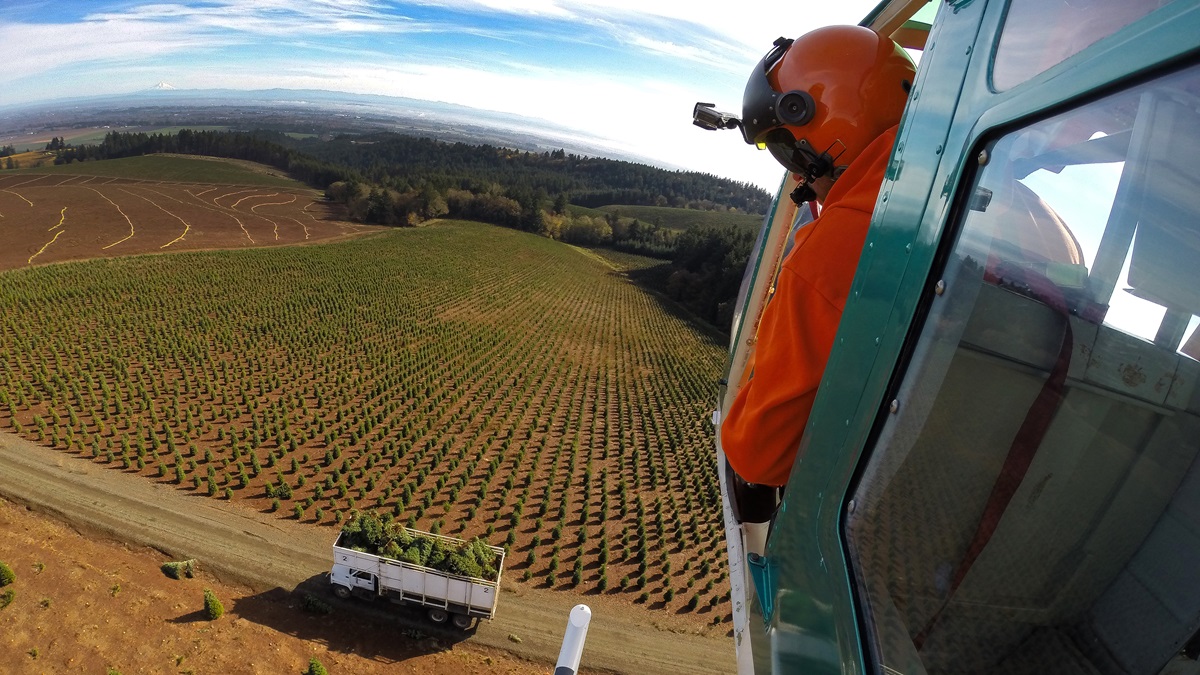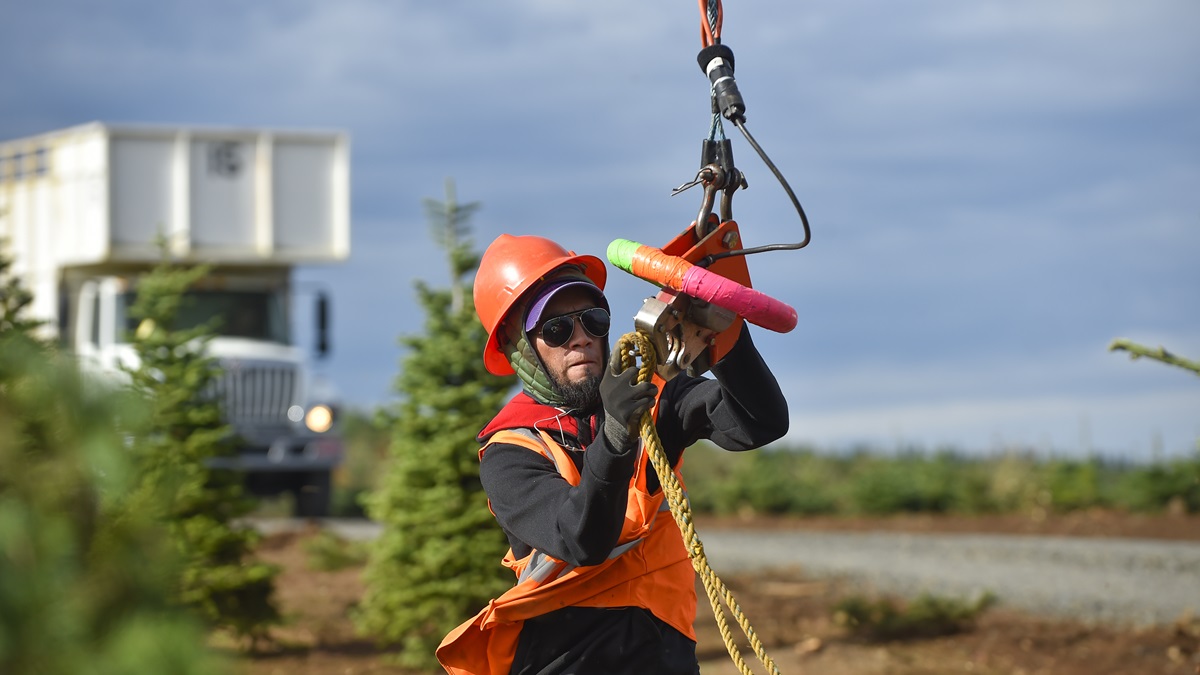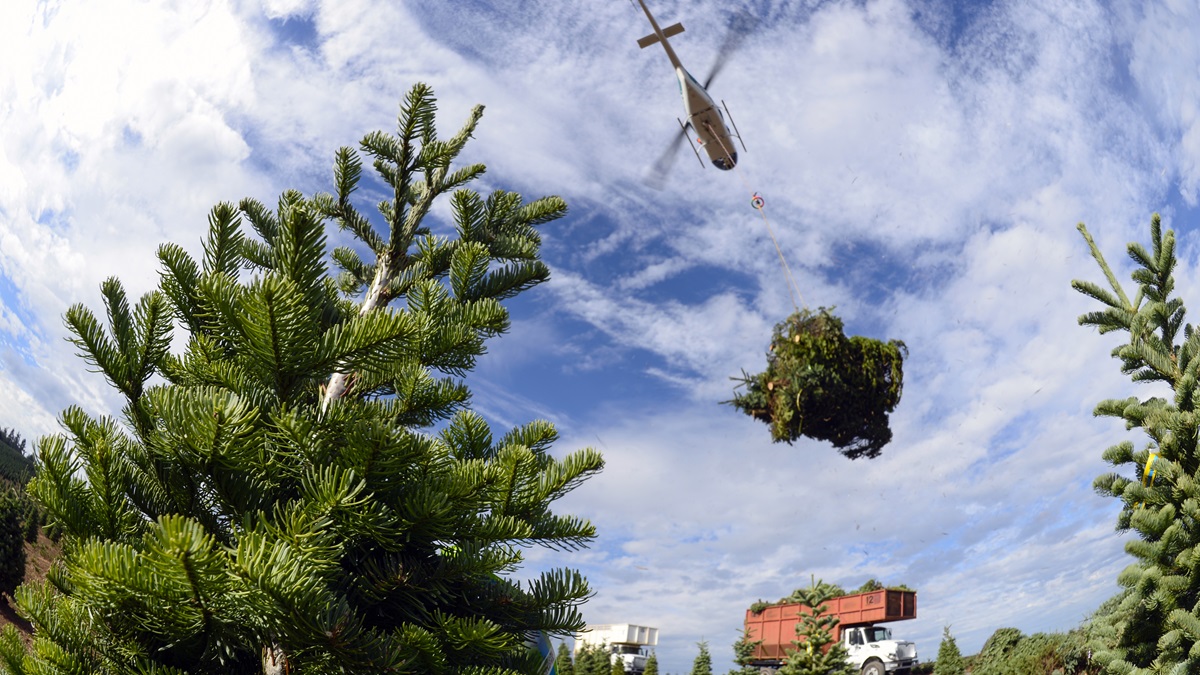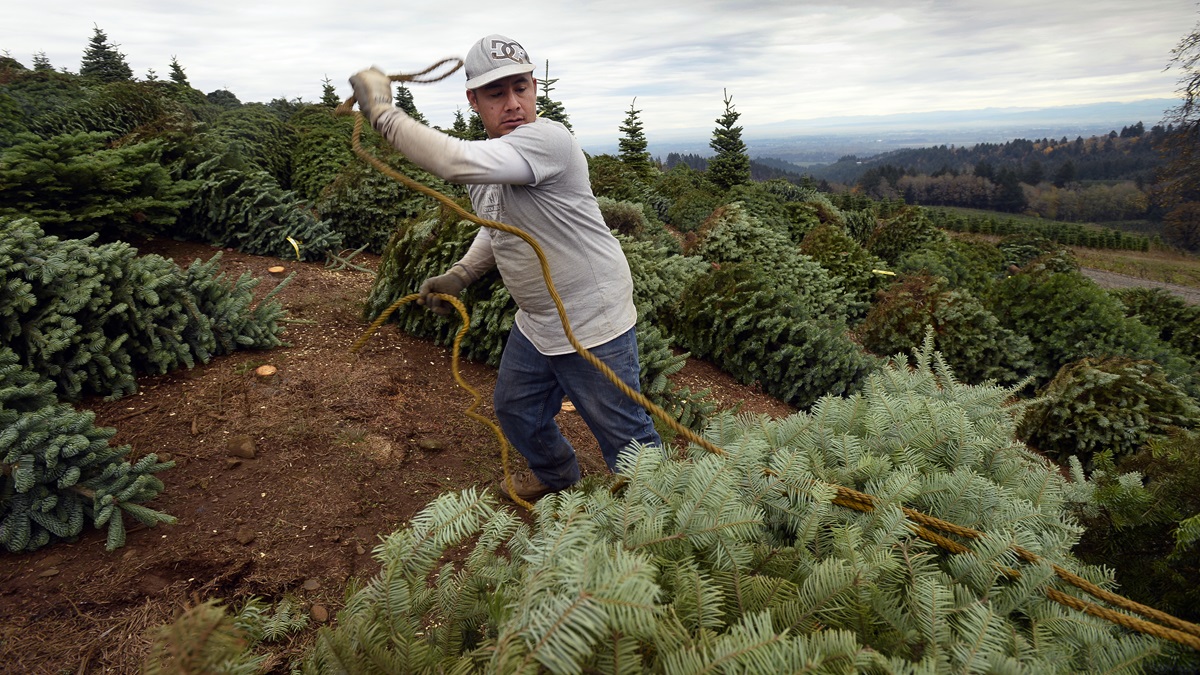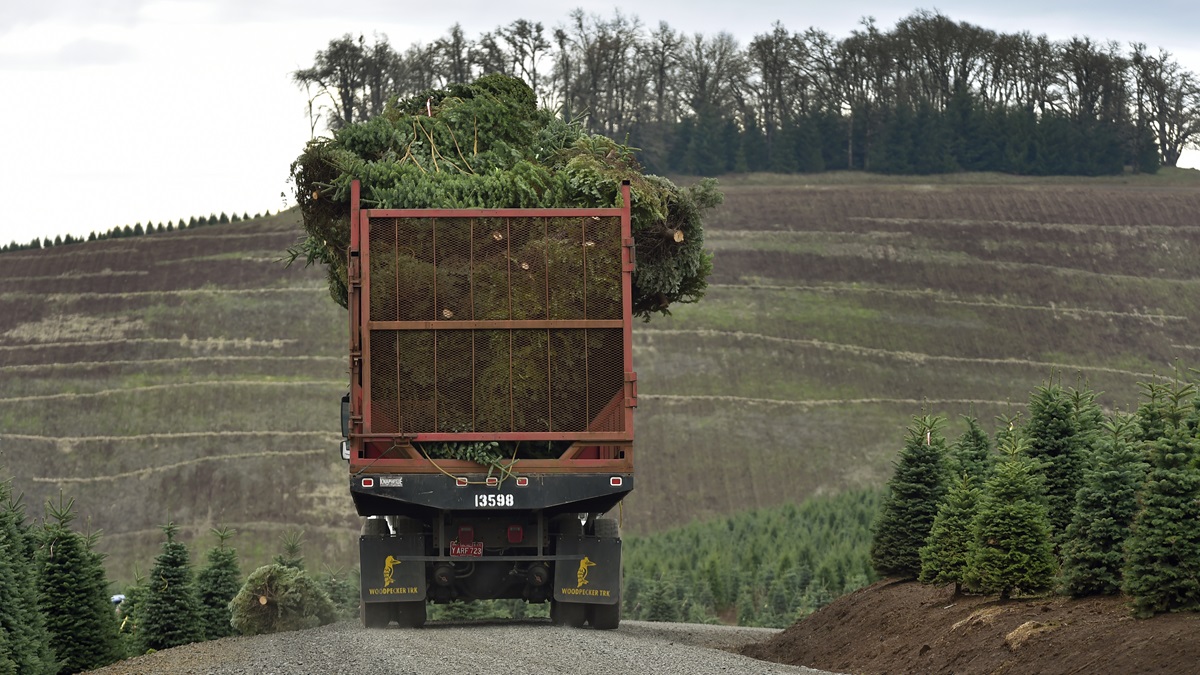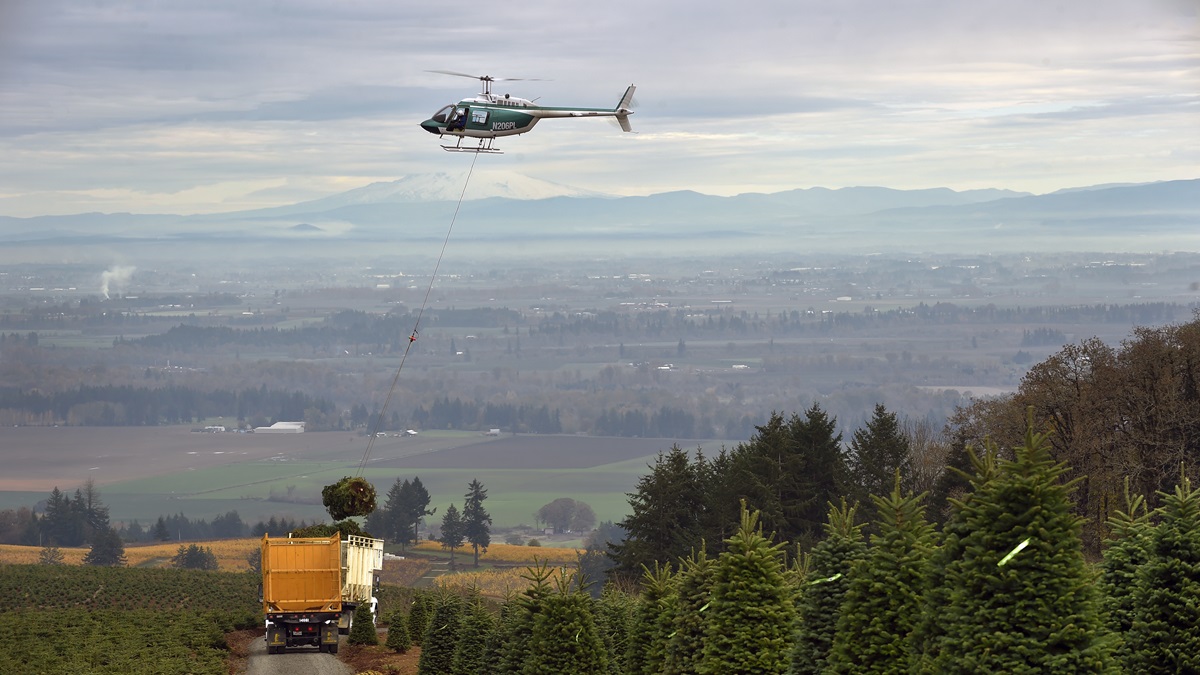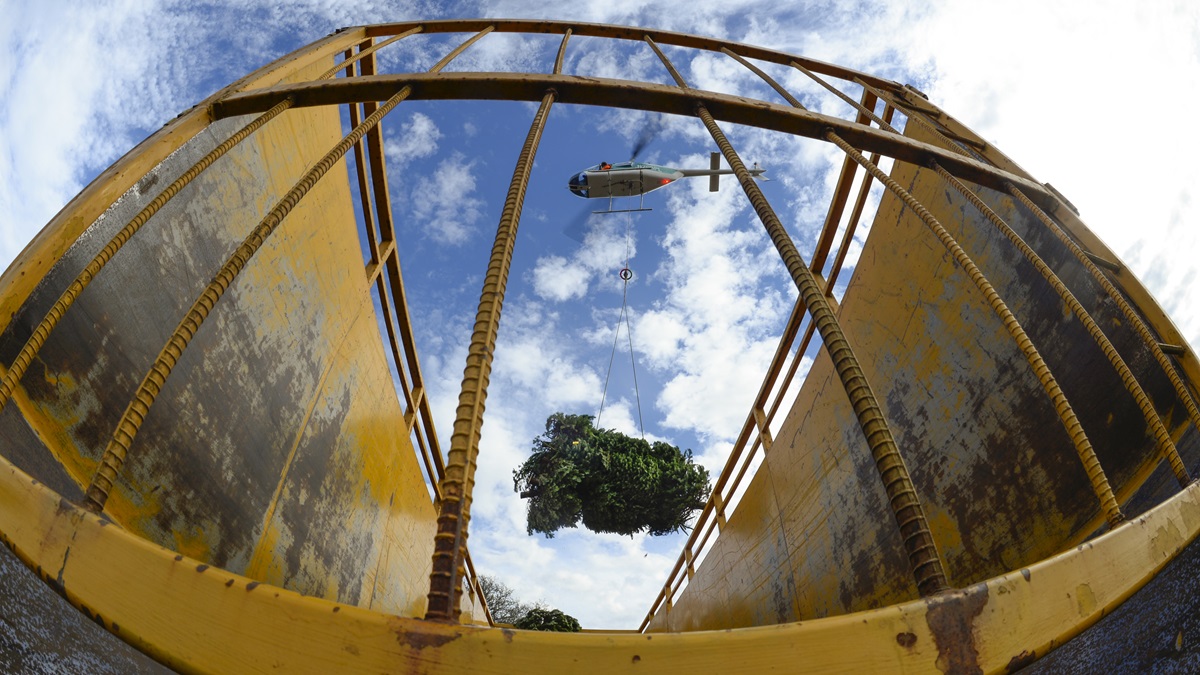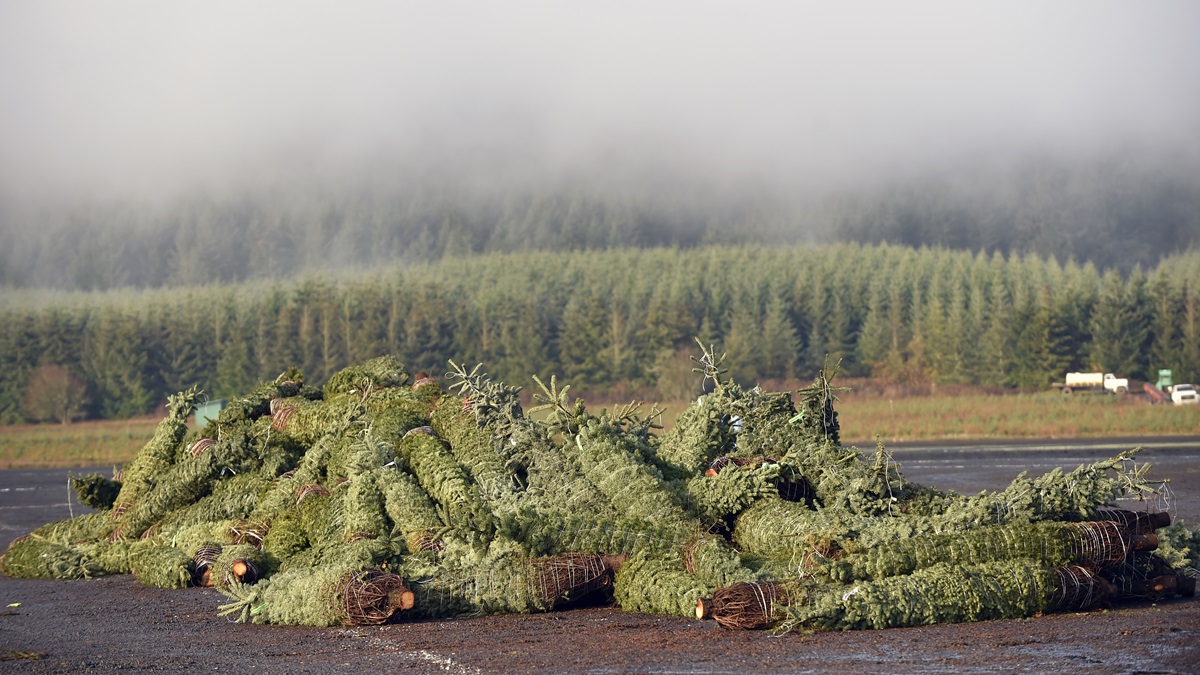Dance of the flying Christmas trees
Helicopter harvest spreads cheer
For 41 years, Noble Mountain Tree Farm pilots have perfected a dance they began in 1976, when The Hustle and the bump ruled discos and dives. Seven days a week beginning every November 1, helicopter pilots snatch loads of prized Noble firs from the steep hillsides before the trees are slung into open-topped trucks and caravanned down jagged Willamette Valley switchbacks to an armada of delivery vehicles, and ultimately into living rooms and dens across the country just in time for the holiday.
Pigs, hookers, and tubs
Despite rain, sleet, snow, or fog encountered during the short harvest, about 10,000 evergreens every day are lofted beneath the skids of Bell JetRangers, MD 500s, or Hiller UH–12s maneuvering up and down 60-percent grades with 600-pound bundles of fir tugging against their rotor blades.
Once the trucks are loaded, sometimes stacked so high that evergreens hang past the front windshield, drivers zigzag down Noble Mountain (elevation 1,163 feet) past rows upon rows of mature trees and 600,000 fresh seedlings before bailers squeeze the trees into plastic bundles and palletize them onto piggyback trailers affectionately called “pigs.” Pigs carry the trees to market, while refrigerated trucks, or “reefers,” take the firs overseas.
Pilots learn to dangle a 25- to 30-foot line to ground crews that have sawed, bundled, and harnessed a dozen or so trees into a rope or sling that is caught by a hooker on the ground. The sling bundle is then lifted a short distance to waiting trucks called “tubs.” The tow lines are electronically released by pilots hovering over the tubs, and trees slide into the trucks likes pieces of a puzzle.
Helicopter pilots like Burlingham and his colleague Tyler Sturdevant have their own techniques for being at one with their helicopter. Burlingham works for Precision Helicopters, one of the contractors Noble Mountain uses for Christmas tree harvests. Noble Mountain typically has two helicopters working daylight to dark during the short season, with two pilots per helicopter. “You just get into a rhythm and the more like a dancer you can be, the better—although I’m not a dancer,” confided Burlingham.
After a few days Burlingham was still getting used to flying the repetitive, low-altitude missions and knew the operations were “within the dead man’s curve.” “All of our turns are torque turns so it’s easier on the helicopter,” he said. Burlingham figured he averaged 140 turns, or loads, per hour, and the key to success was to look out the left-side door, where the pilot sits, and use vertical—rather than horizontal—references.
“You’re looking straight down,” said Burlingham, who rigged a left armpit brace to ease his body’s contortions while controlling the blades’ collective and to maintain rhythm. “Find out where the hooker is on the ground and decelerate to put the line right in their hands.”
Television stars
In a business where timing is everything, Christmas tree growers in the Pacific Northwest rely heavily on helicopters to perform a six-week aerial ballet choreographed with ground crews to spread joy and happiness to millions of families. Noble Mountain Tree Farm General Manager Bob Schaefer explained how he and his colleagues came up with an idea so innovative the three major television networks of that time came out to see how the helicopter farming was done.
“First we got rid of the power lines, because we were flying in pea-soup fog,” said Schaefer, “then we made 52 nets” that were cradled around bundles of trees. Helicopter pilots transported their fragrant green payloads from the mountaintop to a valley-floor production center a mile away, released their loads, and went back up again. Schaefer said the novel technique attracted so much attention that “other helicopter pilots came up here at night and stole some of our first nets.”
With a condensed harvesting season, mature 10-year-old Noble firs are cut at their maximum freshness and peak fragrance after cold-weather dormancy brought by 40-degree temperatures sets in. It takes a lot of coordination among the helicopters, hookers, tubs, and pigs to maintain maximum freshness as the trees are transported to markets, Schaefer said. “Snow is a real bugaboo and rain is like a sponge,” weighing down the loads and slowing the hectic harvest.
We had one pilot who worked it like a pendulum. He’d come in hot, sling those trees into the truck, and turn back around for another load without ever stopping.” — Bob SchaeferCalifornia Home Depot stores can expect a load of Christmas trees within 48 hours, while customers at Walmart stores from the Pacific Ocean to the Mississippi River can begin their decorations in three to five days. Lately, Noble’s evergreens are taking even longer trips overseas in refrigerated cargo trailers; demand is spiking in Singapore and Vietnam.
Oregon State University’s extension service estimated in 2007 that the region led the nation in Christmas tree production with 6.9 million Noble fir trees. The popular holiday trees thrive in the wet soil near Salem and accounted for $109 million in economic benefits to the state, according to the university. Nobles and their Douglas fir cousins make up 90 percent of all Christmas tree varieties sold during the holiday season.
Schaefer explained the fragrant Noble firs are favorites with families because they hold their needles and they aren’t as messy as other holiday trees. An unexpected benefit of aerial farming is that rotor-blade downwash helps shake dead needles from limbs, making for a cleaner product than ground-harvested trees.
Six- to seven-foot Noble firs retail for about $53, and the helicopter operation includes evergreens ranging in size from brown-tagged 10-footers to orange-tagged 3-foot “tabletops.” Noble Mountain also harvests the thinner-needled native Douglas firs, bushier Grand firs, stout-needled Nordmann firs, and Scotch pine.
Time is money
Schaefer, a rusty fixed-wing pilot with a little helicopter time, can eyeball a pilot and size up whether the company will be ahead or a few cents behind on each load as they work the largest contiguous Christmas tree farm in the world.
You just get into a rhythm and the more like a dancer you can be
the better—although I’m not a dancer.” —Ty Burlingham“We try to keep the flight time between the truck and the hooker on the ground to 20 seconds or so,” said Schaefer, who helps train rookie pilots each year. He figures every second costs him about $0.24, and strives to keep helicopter operating expenses below $1 per tree. “It’s all about speed and efficiency,” he said, as fog banks filled nooks and crags while the dance continued nearby. “I want production pilots, and these helicopter people are a whole different breed.
“We had one pilot who worked it like a pendulum,” said Schaefer. “He’d come in hot, sling those trees into the truck, and turn back around for another load without ever stopping.” Time is money to Schaefer, who was clearly impressed with that pilot’s technique.
He found that experienced pilots with hundreds of hours flying power line patrols or ferrying passengers don’t necessarily make great tree-slinging pilots, but there’s usually room to perfect the moves. “You can tell within three or four days if they get it but last year I had to kick one to the curb,” said Schaefer.
After all, even on the dance floor it takes a while to go from shuffling the Texas two-step to performing a graceful ballroom waltz.
“A great hook tender can make a bad pilot look really good,” confided Burlingham, who has 5,000 helicopter hours but clearly struggled at times learning his new dance routine.
Burlingham and Schaefer both agree that safety is paramount, even when trying to beat the clock. “If things don’t seem right, back off a little bit,” noted Burlingham. He is aware of hook movements, winds, approach speeds, ground crew movements, and tail rotor effectiveness on every run. “At the end of the day you want to go home every night.”
On a rare sunny day with snow-covered Mount St. Helens, Mount Adams, Mount Hood, and Mount Jefferson angling skyward from the distance, Schaefer stopped to pick up an errant tree that fell from a truck and noted that Noble Mountain’s terrain encompasses some of Oregon’s steepest land for Christmas tree farming. “Sometimes you’re holding onto it for dear life, but it grows a wonderful tree, a fantastic tree. It’s fun to think about how many thousands of families we touch” for the holidays.AOPA
Email [email protected]

